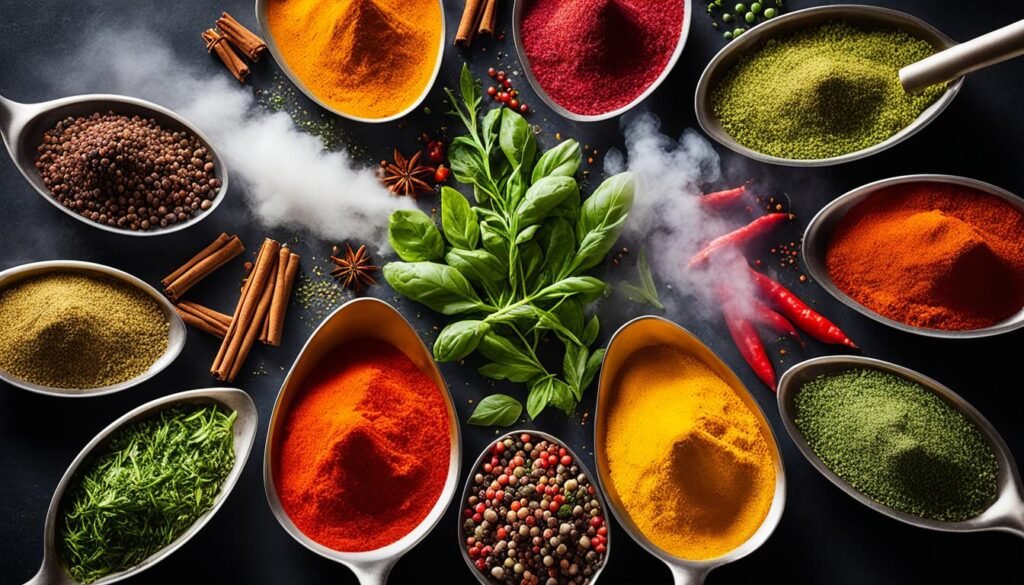Explore the Flavorful World of Culinary Arts
Imagine you’re entering a lively culinary school. The room hums with the sound of cooking and rich scents. You see future chefs at work, dicing ingredients, mixing, and decorating tasty dishes. This scene oozes energy and love for cooking, making you eager to join the culinary adventure.
If you’re passionate about cooking or just interested, the world of culinary arts awaits. It’s not just about cooking; it’s about understanding food at its core. Culinary education uncovers the secrets behind delicious meals and the many paths in the food industry.
At culinary schools, you learn the ropes from professional chefs. They teach you everything from analyzing flavors to using different cooking methods. You get to experiment with recipes while exploring new trends. This journey of learning never ends, as you’re always trying new things in the kitchen.
Key Takeaways:
- Introduction to Culinary Arts opens up a world of infinite possibilities in the culinary industry.
- Through culinary programs and professional chef training, students acquire skills in cooking techniques and food preparation methods.
- Understanding flavor profiles is essential in culinary arts.
- Culinary education equips students with the knowledge to create diverse and delicious dishes.
- Embarking on a culinary arts journey is an exploration of creativity and culinary innovation.
The Parts of the Flavor Profile
Understanding a dish’s flavor profile is key to making it outstanding. It combines different elements for a memorable taste. They are taste, aroma, and mouthfeel.
Taste: Exploring the Primary Tastes
Taste is easily identified and well-known in flavors. It includes the five main tastes: salty, sweet, sour, bitter, and umami. These tastes add layers to dishes, making them complex and rich. Saltiness and sweetness, for instance, bring balance and richness to food.
Aroma: The Scent of Flavor
The smell, or aroma, is vital in flavor perception. It can bring back memories and create excitement. Aromas can be cozy or fresh, taking us to other places. The scent of food and its taste work together, making a delightful symphony for the senses.
Mouthfeel: The Texture of Flavor
Texture and physical feeling in our mouths are also important. It includes how smooth, creamy, crunchy, or thick food is. These qualities affect how we enjoy the taste. Think of the difference in experience between eating a chocolate mousse or crispy fried chicken.
When balanced well, these elements make a dish truly unforgettable. Chefs aim to harmonize taste, aroma, and mouthfeel. This creates a delightful culinary journey that stays with you.
How Culinary Students Experiment with Flavor Profiles
At schools like Escoffier, culinary students get to play with flavors in a unique way. Experimenting with various taste combinations is a big part of their education. This helps them grow their skills and make unique, tasty foods.
Guided by Chef Instructors, students learn the art of mixing flavors well. These experienced chefs share secrets on what tastes good together. They give advice to make the student’s dishes even better.
The Escoffier Flavor Wheel is a favorite tool among these students. It helps them describe and understand flavors better. Using this wheel, students refine their taste senses. They learn to make flavors work in perfect harmony.
Creating menus and recipes is vital for a culinary student. Through this, they learn how to pair different flavors and ingredients. They get to be creative, trying new blends and cooking methods.
Studying cuisines from around the world is also part of their education. This broadens their flavor understanding and cooking styles. It makes them well-rounded chefs, ready to tackle any cuisine.
After lots of practice and knowledge gained, these students are set for the culinary world. They’re ready to create menus and recipes that wow their customers. It’s all about knowing flavors inside and out.
Understanding Flavor Profiles Can Help Your Career
Knowing flavor profiles well is key for chefs. It lets them play with tastes and create exciting dishes. This skill makes chefs stand out and keeps their customers happy.
Chefs should make dishes the same every time. This skill leads to good reviews and keeps customers coming back. It’s all about making flavors that work well together.
Describing flavors is important for jobs like food critique or recipe developer. They must talk about tastes clearly. This helps them make enjoyable content or recipes.
Staying updated on food trends is vital for chefs. It helps them keep their menus fresh. By using new flavors and techniques, chefs keep their customers interested.
“Flavor profiles are the language of the culinary world. Understanding this language is the key to success in your culinary career.”
If you dream of a culinary career, understand flavors well. It will boost your journey, no matter your job in the food industry. Use flavor skills, stay updated, and you’ll impress anyone with your dishes or writings.
The Richness of Culinary Exploration
Culinary exploration takes us on a thrilling journey. It lets us enjoy the variety, cultural flavors, and the joy of food. This journey teases our taste buds and sparks creativity with every new dish we try.
The beauty of a dish is not just in its taste. The colors, arrangement, and how it’s served make eating a delight. This artful presentation not only satisfies us but is also a feast for our eyes.
Exploring new recipes introduces us to different ingredients and cuisines. It’s a way to widen our food world and find mixes that excite our taste. Whether in our own kitchen or trying global foods, it opens us up to varied flavors.
Diving into food from around the world shows us rich and varied cultural heritages. Each ingredient, technique, and taste tells a story of its people. This exploration helps us understand different cultures and appreciate their food traditions.
Exploring food is to break free from rules and set paths. It’s an open field for creativity, where we can make and enjoy meals how we like. This lets us push the limits of what we know and bring our unique flavor to dishes.
To truly enjoy culinary exploration, remember the moments and flavors. The smells and tastes can take us to past places and times. These memories and senses are woven into our love for food and the tales it carries.
Culinary exploration does more than fill our stomachs. It builds connections, crossing cultural divides, and bringing people together. It’s in shared meals that friendships and family ties grow strong.
In the end, exploring food is a chance for a fulfilling journey. It’s about embracing culture, enjoying the experience, and letting our creativity flow. This adventure satisfies our curiosity and feeds our souls through the power of food.
Evolving State of Culinary Arts
The culinary arts world is always changing. Talented chefs act as both artists and scientists. They break the rules of cooking and create new dishes we’ve never seen before.
Molecular Gastronomy: Exploring the Science of Cooking
Molecular gastronomy is cooking using science and creativity. Chefs use special techniques and look at how ingredients change. This makes food both beautiful and delicious, changing how we enjoy meals.
Fusion Cuisine: A Melting Pot of Flavors
Fusion cuisine mixes different food cultures and flavors. Chefs combine various ingredients and cooking styles to make dishes that are new but fit together well. This way of cooking celebrates the world’s food diversity.
Pushing the Boundaries with Avant-Garde Techniques
Today’s chefs are always trying new things. They use cool cooking methods like sous vide and make food items like edible foams. These methods make meals taste better and look amazing, making eating an experience for all senses.
Redefining Gastronomy for the Future
Chefs change the cooking game by trying new ingredients, updating old recipes, and creating new ones. Their fresh ideas and daring dishes leave a mark on diners. They are setting the table for what’s next in food.
| Innovation in the Kitchen | Molecular Gastronomy | Fusion Cuisine | Avant-Garde Techniques | Redefining Gastronomy |
|---|---|---|---|---|
| An exploration of new ideas and concepts | An approach that combines science and creativity | The fusion of different culinary traditions | The adoption of unconventional cooking methods | A transformation of the culinary landscape |
| Experimenting with ingredients and flavors | Utilizing avant-garde techniques like spherification | Blending diverse culinary styles | Creating visually stunning presentations | Pioneering new culinary experiences |
| Pushing the boundaries of traditional cooking | Exploring chemical and physical transformations | Innovating flavor combinations | Transforming dining into a multisensory experience | Shaping the future of gastronomy |
Culinary arts continue to grow because of chefs’ creativity and dedication. With new approaches like molecular gastronomy and fusion cuisine, they delight our taste buds. The future of food promises exciting dishes and flavors.
Culinary Exploration and Shared Experiences
Exploring food is more than just eating. It brings people together and creates memories. Meals act as a bridge for social gatherings. They unite people of different backgrounds over a love of good food and friendship. Sharing a meal can cross cultural barriers, making space for diversity and open conversation.
These shared experiences help us build strong connections and feel like we belong.
“Food is our common ground, a universal experience.” – James Beard
Dinner parties help us share our culture and food with friends. Guest bringing their own dishes creates a beautiful cultural mix. This turns into a sharing of not just food but stories and traditions. At these times, laughter and new friendships are born.
Connecting Through Food
Food doesn’t just taste good; it brings people closer. It sparks memories and stories. Fresh bread, sizzling pans, or well-presented dishes speak a language everyone understands.
Dining experiences reach beyond our homes. They connect us through a shared love for food. Events like food fairs and cooking classes are perfect for meeting new people who think alike. Here, recipe sharing and learning from others are common.
Embracing Community Engagement
Food connects us to our community and its diverse culinary traditions. It’s about trying new things and expanding our food knowledge. Getting involved in local food scenes supports businesses and makes our communities better places.
This engagement broadens our understanding of the world’s food and culture. We share stories and traditions over meals, creating a global perspective. This deepens our respect for the variety of culinary heritage out there.
Host Your Own Culinary Gathering
Ready to host a dinner party? Here’s how to make it special and welcoming:
- Set a beautiful table and play music that goes with the food’s theme.
- Ask guests to bring a dish from their culture or one that’s special to them.
- Introduce each dish so everyone can appreciate its story.
- Start conversations with topics about food, travel, or cultural experiences.
- Think about adding fun things like cooking shows or a DIY food station.
A dinner party is more than sharing a meal; it’s about creating lasting connections. It celebrates diversity and strengthens relationships. Through these gatherings, our hearts and minds are nourished.
Culinary Adventures at Home
Why just eat at restaurants when you can cook global meals at home? The joy of encountering new dishes and ingredients is now at our fingertips. Use online recipes to travel through tastes and learn the art of cooking from different places. Let’s find out how we can use local influences and fresh market finds to create amazing dishes.
Recipes from Around the World
Even if you can’t travel, your kitchen can take you worldwide. Cook dishes from Italy, Thailand, Mexico, or Morocco. Make a tasty pasta carbonara, enjoy a spicy curry, dip into Mexican salsa, or savor a Moroccan tagine. Using the internet, it’s easy to cook these global meals.
Experimentation for Culinary Creativity
Your kitchen is like a science lab waiting for you to experiment. Try new foods and cooking techniques to see what you like best. Put exotic fruits in your smoothies, special spices in your marinades, or try new cooking styles. This helps you become a better cook and surprise your loved ones with unique meals.
Regional Influences and Farmers’ Markets
There’s magic in cooking with local ingredients. Try to cook with products from your area, like special tomatoes or handmade cheeses. Also, visiting farmers’ markets opens a door to new recipes and ideas. They are great places to find fresh foods and talk to local farmers.
Shopping at farmers’ markets is inspiring. You’ll see everything from fresh fruits to craft cheese. They are full of good stuff for your meals.
Using these fresh foods can really improve your dishes. The bonus is you’re helping local farmers and the environment.
Farmers’ Market Ingredients and Regional Delights
| Ingredient | Region | Delight |
|---|---|---|
| Heirloom Tomatoes | Southern United States | Caprese Salad |
| Fresh Corn | Mexico | Elote (Mexican Street Corn) |
| Artichokes | Mediterranean | Grilled Artichokes with Lemon Garlic Aioli |
| Lavender | Provence, France | Lavender-infused Crème Brûlée |
| Avocado | California, United States | California Avocado Toast |
Exploring regional farmers’ markets not only offers a delightful sensory experience but also provides a unique opportunity to connect with local producers and discover hidden culinary gems that will elevate your dishes.
Why not start now? Imagine, create, explore, and refresh your taste with each dish. Cooking at home is a wonderful journey into new flavors and culinary learning.
Learning Through Hands-on Experiences
Joining cooking classes and workshops is a great way to learn about food. You get to work with chefs who love teaching their craft. They share their stories, skills, and the meaning behind each dish.
Through these sessions, you can explore different food cultures. With experienced chefs’ help, you learn about various foods and cooking methods. This makes you admire the effort needed to cook a great meal.
Explore a World of Culinary Traditions
These classes open the door to a fun culinary journey. You can pick from making pasta in Italy, cooking street food in Thailand, or learning pastry in France. There’s something for everyone, and it’s not just about the food. You get to know each culture through its cuisine.
“Cooking is about so much more than just putting food on the table. It’s a form of cultural preservation, a way to carry forward the flavors and traditions of generations past.” – Chef Julia Martinez
The Benefits of Hands-on Learning
Learning to cook has many perks. It’s not just in a classroom. You actually cook. This way, you:
- Learn basic cooking skills
- Get better at using knives and preparing food
- Become braver in trying new flavors and foods
- Learn to manage time and be organized in the kitchen
- Get quick advice from chefs
These classes add a lot to your cooking knowledge. Plus, you meet others who love food as much as you do.
Expand Your Culinary Horizons
For any cook – from amateur to expert – these classes offer tons of growth. You’ll taste new things, master new skills, and learn about different foods. It’s a chance to keep getting better in the kitchen.
| Benefits of Cooking Classes and Workshops | Examples of Popular Culinary Topics |
|---|---|
|
|
To grow in cooking continue to take classes and workshops. They’ll refine your skills, introduce you to new tastes, and teach you more about food. The best way to learn is by doing, so get ready to cook and have fun!
The Universality of Food and Culinary Adventures

Food and exploring new dishes involve all our senses. It’s more than just taste. It’s about how it smells, feels, and looks. The sound of cooking and the warmth we feel from eating connect us to the experience.
Trying new foods lets us connect with other cultures. It lets us taste the history and traditions of different places. Eating a meal from Italy, India, or Japan lets us experience their unique way of life.
Food also brings back memories. The smell of fresh bread can remind us of happy times as a kid. Eating a family recipe can make us feel right at home. These moments add joy and link us to our past.
“Food is our common ground, a universal experience.” – James Beard
Eating is something we all share, no matter where we’re from. It brings people closer and opens hearts. Whether we’re far from home, or with friends who come from different backgrounds, sharing a meal together spreads happiness and understanding.
Looking at food as an adventure gives us the chance to learn and grow. It spices up our lives, introducing us to new tastes and customs. We learn more about others, enjoy our own memories, and take part in something that everyone loves: eating.
Cultural Connections Through Food
| Cuisine | Cultural Connections |
|---|---|
| Italian | Rich history, pasta-making traditions, regional specialties |
| Indian | Spices, diverse regional cuisines, vegetarian traditions |
| Japanese | Attention to detail, umami flavors, sushi culture |
| Mexican | Aztec and Mayan influences, chili peppers, tortilla-based dishes |
| Chinese | Diverse regional cuisines, intricate cooking techniques, tea culture |
Embracing Culinary Adventures
Embracing culinary adventures is all about stepping outside our comfort zones. It’s about exploring new flavors from around the globe. This journey can happen through travel, hosting dinners, or trying different recipes at home. There are many paths to take in this delicious adventure.
Breaking Out of Comfort Zones
Stepping out to try new things is at the heart of culinary adventures. It is normal to feel a bit unsure about trying new foods. But, these moments help us grow and become more open to new flavors.
By expanding our food horizons, we find exciting tastes and meals. Without taking these steps, we might miss out on amazing dishes and recipes.
Exploring Diverse Flavors
Discovering new flavors from different parts of the world is truly rewarding. We can enjoy street foods in Asia, spices from the Middle East, or the zest of Latin American dishes. Every culinary tradition offers something unique and exciting.
Exploring these diverse flavors leaves us wanting more. It inspires us to keep trying new dishes and enjoying various cuisines. Surely, it’s an adventure for our taste buds.
Traveling for Culinary Delights
Traveling lets us dive into local food cultures. From vibrant markets to top restaurants, each place has its special flavors. This immersion helps us understand different cultures better.
It’s a way to truly taste the essence of a place. This experience broadens our worldview and deepens our appreciation for cultural traditions.
“Traveling is like tasting a whole new world of flavors. It’s a feast for the senses, an adventure that stimulates both our taste buds and our curiosity.” – Anthony Bourdain
Hosting Themed Dinners
Hosting dinners themed around different cuisines is a fun way to explore new tastes. From a Mexican party to an Italian gathering, there are endless possibilities. These events bring others along on your culinary journey.
Such dinners not only showcase your cooking skills but also inspire others. They encourage everyone to try something new and add excitement to meal times.
Embracing culinary adventures opens the door to a vast world of flavors. It encourages us to try new tastes and dishes, be it from far-off lands or our own kitchen. Enjoy this journey as you dive into the rich, diverse world of food.
Conclusion
The world of cooking is exciting, offering a journey filled with *flavor exploration*, *cultural connections*, and *personal growth*. It doesn’t matter if you’re training to be a chef or cooking at home for fun. Cooking provides lots of chances to be creative and learn about different flavors.
By learning cooking methods and taste profiles, you can start a delicious adventure. This journey will make you better at cooking and help you understand different foods better.
Exploring food links you to various cultures, uniting people through meals. Every meal shares a story of its region, showing its history and customs. This comprehensive journey helps you understand others and connect through food.
Why not start your own *lifelong journey* in cooking? Dive into the exciting, flavorful world of cooking. It doesn’t matter if you’re a chef or just love cooking at home. Cooking is a rich, satisfying path that encourages you to enjoy every bite. Bon appétit!
FAQ
Q: What is a flavor profile?
Q: How do culinary students experiment with flavor profiles?
Q: Why is understanding flavor profiles important for culinary professionals?
Q: How does culinary exploration celebrate diversity and cultural influences?
Q: How does innovation in the culinary arts push the boundaries of gastronomy?
Q: How does culinary exploration foster community engagement and shared experiences?
Q: How can individuals pursue culinary adventures at home?
Q: How do cooking classes and workshops contribute to culinary exploration?
Q: How does culinary exploration enhance our daily lives and understanding of the world?
Q: Why should individuals embrace culinary adventures and break out of their comfort zones?
Q: What can individuals gain from a lifelong journey in culinary arts?
Source Links
- https://www.linkedin.com/pulse/food-culinary-adventures-exploring-worlds-flavors-mann-talat-1f
- https://www.escoffier.edu/blog/culinary-arts/how-culinary-students-explore-flavor-profiles/
- https://jeffreynessia.medium.com/culinary-chronicles-exploring-the-world-of-flavor-general-overview-jeffrey-nessia-57df003609c9?source=rss——travel-5







